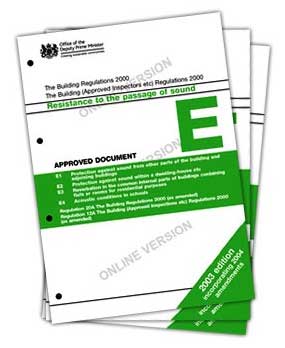 Tomorrow’s Flooring
Tomorrow’s Flooring
Acoustic Flooring: Why Part E Compliance Alone is Not Enough.
When selecting a building product for a particular aspect of a construction project, it’s very easy to focus completely on that product’s main application. So, when seeking out an effective acoustic flooring solution, it’s tempting to think about Part E of the Building Regulations and set all other considerations aside. While, of course, it’s crucial that you do ensure acoustic flooring products are Part E compliant, to do so exclusively runs the risk of missing out on the many potential benefits of a well-rounded, multi-purpose solution.
Before we move on to these other benefits, let’s take a brief look at the requirements of Part E. There is a minimum acoustic insulation requirement of 45dB or greater for airborne noise (43dB for refurbishments) and 62dB or less for impact noise (64dB for refurbishments). Any acoustic flooring manufacturer should be able to supply evidence of independent testing by either ANC approved or UKAS accredited bodies for field and laboratory tests respectively to support any claims they make on behalf of their floor soundproofing solution. Particularly when it comes to Pre-Completion Testing (PCT) products, you don’t want to find your acoustic flooring underperforming once it’s already installed and sitting beneath a screed or final floor finish.
So, now you have an effective acoustic flooring solution or, at the very least, a Part E compliant solution. But what else can your acoustic flooring product bring to your construction project? What other problems can it help solve?
How about sustainability? The Code for Sustainable Homes requires that all products be responsibly sourced, so ensure your acoustic flooring is playing its part. You should, where possible, be sourcing products that are made from recycled materials and are 100% recyclable, zero GWP (Global Warming Potential) and zero OPD (Ozone Depletion Potential). It’s no good specifying a Part E compliant soundproofing material if it fails to meet the good practice guidance for selecting “environmentally preferable materials”.
It goes without saying that you’ll be considering price when sourcing your acoustic flooring, but you’ll need to think about more than just the cost of the product itself. A considerable saving can be made, particularly on larger projects, if you specify a relatively thin soundproofing product, reducing overall construction height. Better an acoustic material that meets Part E at 3mm than one that does the same job at 10mm. Budgets can also be controlled by identifying a product that is effective across multiple applications, rather than a number of products that are suited to only single applications. For example, an acoustic material that works with a variety of subfloor types, is compatible with a number of floor finishes and is suited to a range of environments will enable you to benefit from economies of scale when purchasing.
Taking account of the information above will guarantee you get the most out of your acoustic flooring products, but there will almost certainly be other opportunities, depending upon the project.
For example, if you’re working with an uneven floor, an acoustic cradle can help level out the floor whilst providing soundproofing properties.
It’s really a case of ruthlessly interrogating your acoustic flooring product: “I know you’re Part E compliant, I know you’re resistant to impact and airborne noise, but what else are you good for?”


Comments are closed.